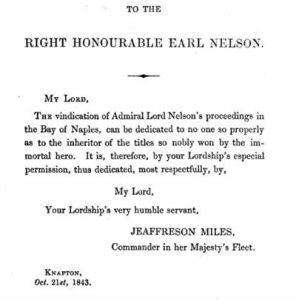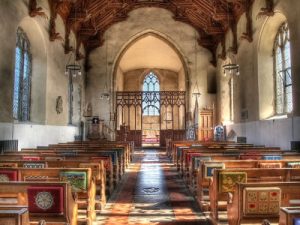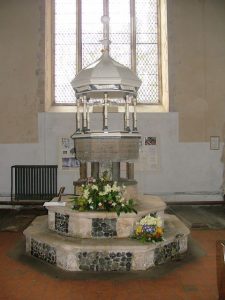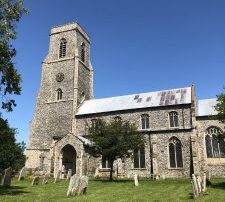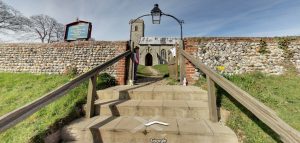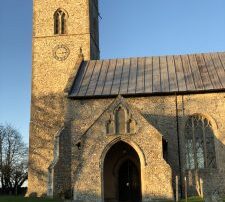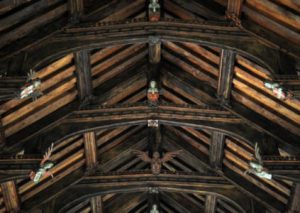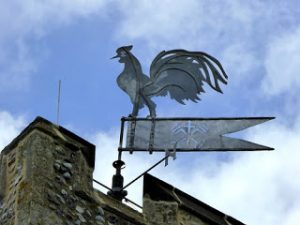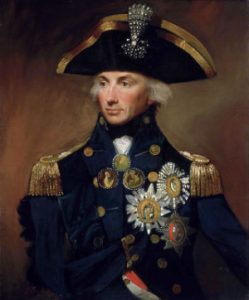Welcome to St Peter & St Paul’s Church
Visiting Knapton’s parish church is a truly astonishing experience!
As you walk through the fourteenth century porch and pass through the large heavy oak doors into the church, your eyes are immediately drawn to the thirteenth century stone font infront of you. But your eyes are soon drawn up to the hammerbeam roof soaring high above you, and you’ll marvel at the sheer number of ornately carved and painted angels… the quality of the craftsmanship is awe-inspiring.
Visitors to St Peter & St Paul’s enjoy a rich historical experience dating back over almost 900 years, brought to life by a 40-page full colour Guide Book (available in the church, by donation).
A Grade I listed building, our church dates from mainly the 14th century, though it has seen many changes and additions over the centuries.
The fabric is largely of whole flints and there are still has some areas of original render.
The tower, which is set to the north west corner of the building, is of knapped flints and is set to one side, probably to allow the church to have a great west window which, apart from looking glorious, illuminates the nave.
The 14th century south porch has a triple niche above with cusped ogee arches, remarkable for its day.
There was almost certainly an earlier church on this spot as evidenced by the oldest historic feature in the church, a 13th century octagonal font in its traditional position opposite the doors. Up three high steps is the Purbeck marble bowl with typical shallow arcading.
It has a wooden cover carved in 1704 which bears a Greek inscription reading:
NIYON ANOMHMA MH MONAN OYIN
which translates as ‘Wash thou, not only my face, but my transgression’.
The inscription is a palindrome, reading the same backwards as forwards.
The chancel was greatly embellished by the rector John Smith who, in 1504, gifted the church its magnificent double hammerbeam roof which still retains its original colour today (see below)
The beams and spandrels are richly carved with three tiers of angels which have outspread wings, with more angels carved on the king-posts and on the wall plate, collectively known as the Knapton Angels (see below)
In niches below the wall supports there are figures with scrolls, shields, symbols or musical instruments.
On the west tower there is a weathervane designed by J.S. Cotman an artist famed as a member of the Norwich school (see below)
The Historic Environment Service report by Stephen Heywood – 2014
Description…
This 19-page conservation-base research and analysis report forms part of the investigative stage of grant-aided repairs and development. It uses photographs to emphasise the relevant points.
In English…
This nineteen page report provides a good general overview of the church as it was in 2014, doffing its cap towards its history and noting those areas that perhaps could use some TLC.
Please note, it’s a big file…
Further indication that this was not the first church on this site is a culturally significant collection of Grave Covers dating back to 1120,
and then there is the Nelson connection…
The Nelson Connection
In the graveyard of St Peter & St Paul’s is a headstone in sacred memory of Commander Jeaffreson Miles of the Royal Navy, the Vidicator of Nelson.
In 1843, the same year that Nelson’s Column was erected in Trafalgar Square, he wrote his pamphlet (which was the size of a small book) entitled;
Vindication of Admiral Lord Nelson’s proceedings in the Bay of Naples
He was defending Nelson’s reputation which had come under increasing attack when Charles James Fox, leader of the Whig (forerunners of today’s Liberal Party) opposition, quoted letters in Parliament in 1800 about alleged atrocities that were said to have taken place in Naples in 1799. These letters were compiled into a book by Helen Williams, a pro-republican, and the attacks became known as the Black Legend.
So what happened in Naples?
As always, there are two sides to every coin, so we’ve put together a shortened version…
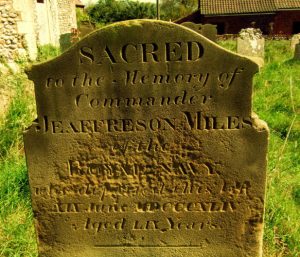
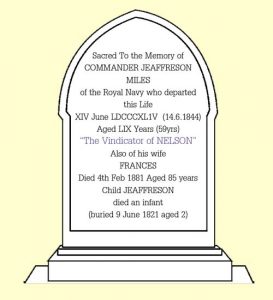
Admiral Lord Horatio Nelson
Horatio Nelson was the unchallenged master of war at sea during the Napoleonic Wars and has been celebrated ever since as the greatest sea warrior in British history.
He was born on 29th September 1758 in Burnham Thorpe, Norfolk, less than 35 miles from our village.
He gave his life winning his greatest victory at Trafalgar on 21st October 1805, ending the greatest threat to Britain and her world position and was transformed into a national deity.
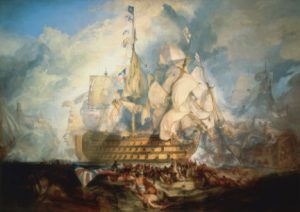
Battle of Trafalgar by Turner
There is an excellent book by Jonathan North called Nelson at Naples, Revolution and Retribution in 1799 which is the result of many years painstaking research by a descendant of Nelson himself and reaches some surprising conclusions at to what exactly happened in Naples, in 1799.
During the wars which followed the French Revolution, France’s armies turned on Britain’s last ally in Italy, the kingdom of Naples. The revolution at Naples was a fascinating but rather bloody episode. The armies of the French republic had chased out the Bourbon royal family and established a liberal government of doctors, lawyers and intellectuals. They lasted six months in office before a ferocious counter-revolution, led by a militant cleric, Cardinal Ruffo, swept them from power. His royalists exacted revenge in the streets or in the courts and on the scaffold. Hundreds died or were imprisoned or exiled, and the kingdom banished its intellectual elite only to find its culture beheaded.
Set within that brutal history is a dramatic story of surrender and betrayal.
By June 1799, as republicans were being hunted through the streets and put to death, a significant number took shelter and were besieged within the forts of the capital. They capitulated to the cardinal on condition they would be safely transported back to France, surrendered and signed a treaty.
It was at this point that Nelson arrived leading his British fleet and the admiral promptly rejected the treaty. Bolstered by the support of Sir William and Emma, Lady Hamilton and with the vindictive Bourbons declaring that there would be no treaty with rebels, Nelson violated the treaty of surrender and annulled the armistice with the rebels. He ordered a court-martial of Commodore Francesco Carocciolo who had commanded the treacherous side’s gunboats and then ordered that he be hanged from the yardarm of Nelson’s flagship, The Minerva, on the evening of 29th June 1799.
Through this controversial act and a tangled sequence of events, hundreds of Neapolitans, thinking themselves saved, now found themselves at the mercy of royalist revenge.
In Italy the event became synonymous with betrayal and Nelson’s honour was called into question by Charles Fox in Parliament.
Nelson’s biographer, the poet Robert Southey, went as far as to state that the episode was a deplorable transaction, “a stain on the memory of Nelson and upon the honour of England“. G. K. Chesterton agreed, writing Nelson turned his blindest eye on Naples and on liberty and another writer later alleged that Lady Hamilton has persuaded Nelson to take her in his barge to view Carocciola’s corpse swinging in the breeze.
Jeaffreson Miles
Jeaffreson Miles was born in Fakenham in 1785 and joined the Royal Navy in 1799, aged 14.
He served all over the world rising through the ranks and was a Lieutenant at the bombardment of Copenhagen and the surrender of the Danish fleet in Sept 1807 when he was included in the general vote of thanks by both houses of Parliament.
During his long and useful career, Cmdr Miles assisted in the capture of;
- 3 colonies
- 26 Line of Battle Ships
- 18 Frigates
- 21 Sloops of War
- and Privateers
He was finally placed on the list of retired Commanders on 28th September 1843.
- both of his children were baptised in Knapton in 1817 & 1818 (Parish Records)
- he appears on the 1841 Census as living in Knapton but not where
- he appears on the 1832/1834/1835 Poll and Electoral List living in
Knapton
From this information, it is certain that he lived in Knapton with his family when he was not at sea on board ship and died at home in Knapton on 14th June 1844.
“Vindication of Admiral Lord Nelson’s proceedings in the Bay of Naples”
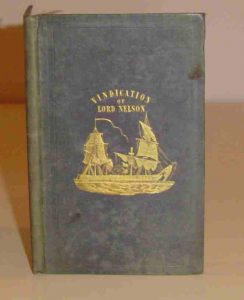
Vindication of Lorn Nelson
So the comments continued, each adding sensational colour and moral outrage.
Commander Miles recognised that the national hero was being attacked by ignorant, petty and stupid people, possibly for their own material gain, and felt that he had to speak out in defence of Lord Nelson’s actions. His 60 page pamphlet made clear that;
- the name of the national hero was being tarnished with lies and misunderstandings
- in fact Nelson had royal authority for his actions in Naples
- those who had made the agreement and brokered the treaty had no such authority to do so
It was published in 1844, just after his death.
…the ground has closed over one of England’s most zealous defenders. His vindication of Lord Nelson’s proceedings in the bay of Naples was published a short time since, and can hardly fail of establishing it’s author’s object; it being a complete refutation the calumnious opinions but too generally received, based upon facts which no sophistry can shake
Gentleman’s Magazine, 1844
